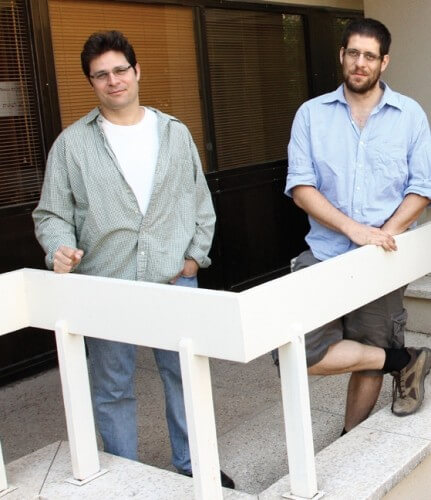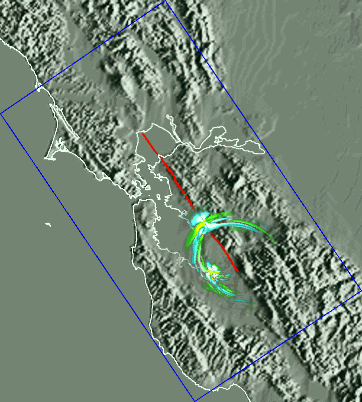Earthquakes occur when two tectonic plates that make up the Earth's crust slide against each other, and the energy stored in the plane of friction between them is released within a short period of time

Earthquakes occur when two tectonic plates that make up the Earth's crust slide against each other, and the energy stored in the plane of friction between them is released within a short period of time. In fact, the ground moves under our feet more often than we are aware of. It turns out that there is another type of earthquake - called a "slow" or "quiet" earthquake - which is not accompanied by a rapid release of energy and strong ground vibrations. Such vibrations last for long periods of time - hundreds of times more - for hours and even days. The total energy release may be similar in both types of earthquakes, but because of the slow release rate of the quiet tremors, they are not felt.
Dr. Eran Buchbinder, from the Department of Chemical Physics in the Faculty of Chemistry at the Weizmann Institute of Science, says that slow vibrations are a common phenomenon. The development of modern methods for geophysical measurements in field and laboratory conditions allows scientists to discover them and their prevalence. Many researchers seek to understand the principles underlying these slow vibrations: are the physical factors influencing them the same as those of the fast vibrations? What determines their speed? There are hints that in some cases, slow tremors precede the fast type, but today it is still impossible to predict which tremors will lead to a devastating event.
In a study recently published in the scientific journal Geophysical Research Letters, Dr. Buchbinder and the members of his group describe how they developed a mathematical model, according to which the slow vibrations are controlled by slightly different physical laws - which explains their relatively slow pace.
Both types of earthquake involve the movement of rubbing contact surfaces. Such surfaces exist in many physical systems, and they play a central role in various phenomena that occur on different scales - starting with nanometer devices and tiny biological engines, and ending with the enormous tectonic plates in the Earth's crust. The strength and stability of these surfaces is of great and fundamental importance: when they are undermined, the result can be disastrous.
Fracture of friction surfaces is related to interrelationships between two factors: the elastic energy stored in the bodies, and the resistance created in the contact surface as a result of the friction. Two bodies - for example, two tectonic surfaces, or a tire of a car and a road - are usually subject to the influence of forces that push them together, and the contact between them causes friction. In addition, forces acting parallel to the surface between the bodies, called shear forces, push the two bodies to slide past each other. In other words, the force of shear pushes the bodies to move, while the force of friction opposes this movement. As long as the resistance created by the friction increases over the shearing forces, the surface and the bodies it connects remain stuck in place. But when the shear forces overcome the frictional resistance, sliding occurs, which is accompanied by fractures that advance along the surface. It is the breaking speed that determines whether the elastic energy - which sometimes accumulates over a very long period of time,
When the shear forces work against the friction force - you will be released all at once, or slowly. In the fast vibration, the fracture progression rate is limited only by the speed of sound - that is, several kilometers per second in normal solids.
Dr. Buchbinder was interested in the question: What makes the slow vibrations slow? Is their speed actually a small fraction of the speed of sound, or is it a different physical size?
To answer the question, Dr. Buchbinder and his research team, which included research student Yohai Bar Sinai, and Dr. Yip Brenner, a visiting scientist from the Peter Grunberg Institute in Germany, used geophysical measurements, as well as data collected by Prof. J. Feinberg's group from the Hebrew University in Jerusalem, which simulates earthquakes in the laboratory. Based on these data, the team of scientists developed a new model, which offers a possible explanation for the dynamics of the slow vibrations.
According to conventional models, frictional resistance decreases as speed increases: faster sliding is also easier. This is the reason why the breaking speed of friction surfaces tends to accelerate until it approaches the limit - the speed of sound. According to the new model, the frictional resistance behaves, initially, as in the previous models, and decreases with the increase in speed. But, at a certain point, the phenomenon reverses, and the friction gradually increases again.

The slow shaking phenomenon probably occurs around the point in the model where friction levels bottom out, and start to rise again. The breaking speed, in this case, is largely determined by the friction properties of the surface, and not by the speed of sound, so it may be much slower.
Dr. Buchbinder and his team members intend to continue testing the model with more complex calculations, and compare their results to experimental measurements, with the goal of creating a useful research tool for understanding the failure of friction surfaces, including earthquakes.
